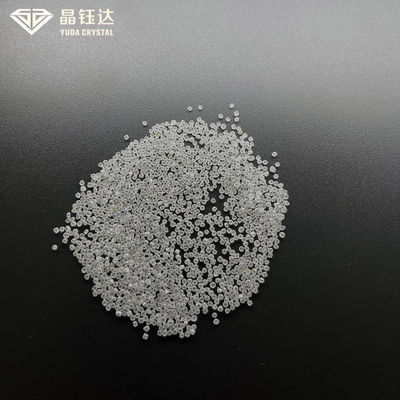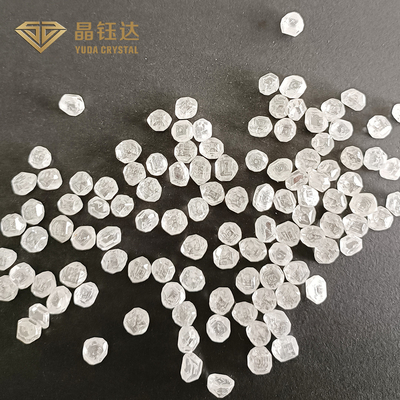35pcs Size DE Color Rough Lab Grown Diamonds For Cutting Star Melee Diamonds
Rough Lab Grown Diamonds Description
The word "diamond" comes from the Greek adamas, which means indestructible. Indeed, diamonds are the hardest material in nature.
Lab-grown rough diamonds are synthesized in a few weeks, while the development of natural diamonds takes billions of years. Since the 1950s, people have begun to produce cultivated diamonds for industrial purposes, and they have been widely used in telecommunications, laser optics, medical care and other fields. In 1970, General Electric produced the first very small gem-quality cultivated diamond that could be faceted like a gem.
By the mid-1980s, other manufacturers were able to produce cultivated diamonds. At first, these cultivated diamonds were almost all small and yellow, but the quality of cultivated diamonds continued to improve. Nowadays, both colorless and colored gem-grade cultivated diamonds are used in jewelry.
In the laboratory, there are two main processes for the manufacture of lab grown rough diamonds.
1. High pressure and high temperature (HPHT)
Using this method to make rough laboratory-grown diamonds, the laboratory simulates the high temperature and pressure conditions of natural diamonds when they are formed underground. HPHT diamonds are manufactured at a pressure of 5-6 GPA (approximately the pressure produced by a commercial jet landing on a human fingertip) and a temperature of 1300-1600°C.
Low-quality natural diamonds and unprocessed natural diamonds can be processed through the HPHT process to improve color and clarity. In addition to increasing the color grade of colorless diamonds, this process can also be used to change the color of the diamond to pink, blue, or yellow.
2. Chemical Vapor Deposition (CVD)
Using this relatively new technology, scientists are able to manufacture synthetic diamonds at moderate temperatures (700°C to 1300°C) and low pressures. The carbon-containing gas is pumped into the vacuum chamber, deposited on the diamond seed, and crystallized into rough laboratory-grown diamonds. The final size of the diamond depends on the time allowed to grow.
Parameters of Rough Lab Grown Diamonds
| Rough Lab Grown Diamonds Details |
| Brand Name |
Yuda Crystal |
| Name |
Rough Lab Grown Diamonds |
| Diamond Color |
D-E Full White Color |
| Diamond Clarity |
VVS-VS |
| Diamond Carat Weight |
Average around 0.03 carat |
| Diamond Cut |
Uncut |
| Technology |
HTHP |
| Size |
1.4 - 2.0mm |
| Shape |
Raw |
| Application |
For Cutting Lab Grown Melee Diamonds |
| Place Of Origin |
Zhengzhou, China |
| Delivery Time |
1 - 7 Working Days Base on Order Quantity |
| Payment Terms |
100% Payment In Advance |
| Payment Methods |
T/T, PayPal, Western Union, Bank Transfer |
| Shipping way |
DHL, FedEx, SF Express, UPS, EMS, TNT etc |
| M.O.Q |
Negotiable |
| Diamond Type |
Synthetic(lab created) |
| Location |
Zhengzhou, China |
| Treatments Applied |
None |
| Fire Dispersion |
0.044(Same as Natural Diamond) |
| Brilliance Refraction Index |
2.42(Same as Natural Diamond) |
| Relative Density |
3.52(Same as Natural Diamond) |
| Chemical Composition |
Carbon(Same as Natural Diamond) |
| Moh's Hardness |
10(Same as Natural Diamond) |
Lab Grown Diamonds Introduction
Natural diamonds are created by nature and are the result of high temperature and pressure formed over billions of years. The Lab Grown Diamonds are produced in the laboratory, usually in a few weeks. The chemical element between the two is same.
So how do you distinguish between lab diamonds and natural diamonds?
There is no obvious difference between the Lab Grown Diamonds and natural diamonds. Even professional gemologists need special equipment to identify them. By zooming in, professionals will be able to discern subtle contrasts in diamond inclusions grown and mined in the laboratory.
| The Difference Between Lab Diamond And Natural Diamond |
| Properties |
Earth Mined |
Lab Created |
| Guaranteed Conflict-Free |
No |
Yes |
| Hardness (MOHS) |
10 |
10 |
| SP3 Carbon Diamond Bonds (%) |
100% |
100% |
| Internal Crystal Structure |
Face-Centered Cubic |
Face-Centered Cubic |
| Hardness Comparable |
2.42 |
2.42 |
| Relative Diversity |
3.52 |
3.52 |
| Color Diffusion |
0.044 |
0.044 |
| Color |
Various Grades |
K to D grades |
| Price |
$$$$$ |
$$$ |
Rough Lab Grown Diamonds Details


 Your message must be between 20-3,000 characters!
Your message must be between 20-3,000 characters! Please check your E-mail!
Please check your E-mail!  Your message must be between 20-3,000 characters!
Your message must be between 20-3,000 characters! Please check your E-mail!
Please check your E-mail! 







